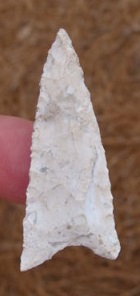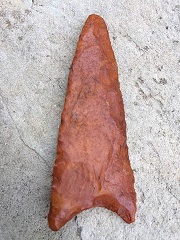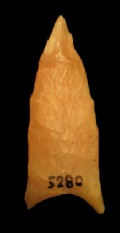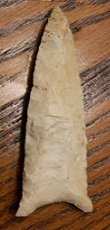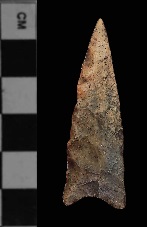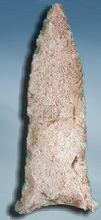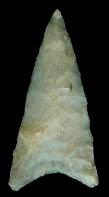Outline is Representative of Size and Shape:

Name Details:
Identified By: John M. Goggins
Named For:
Date Identified: 1950
Type Site:
Identified By: John M. Goggins
Named For:
Date Identified: 1950
Type Site:
Point Validity:
Valid type
Goggin was a distinguished anthropologist and was a professor at the University of Florida. He specialized in the archaeology of the southwest where he completed his undergraduate work and became an expert on the archaeology of Florida. This type was named in a professional publication and has many professional references. This is considered a valid type.
Goggin was a distinguished anthropologist and was a professor at the University of Florida. He specialized in the archaeology of the southwest where he completed his undergraduate work and became an expert on the archaeology of Florida. This type was named in a professional publication and has many professional references. This is considered a valid type.
Santa Fe Auriculate
AKA: Dalton Santa FeCluster:
Description of Physical Characteristics and Flaking Pattern:
This is a thin narrow medium (1.5 to 4 inches) triangular auriculate point with an elliptical to flattened cross section. The blade is excurvate to recurvate (curving in at the tip, straightening out towards the lower portion, and flaring out towards the base). The blade is not serrated as seen in the Safety Harbor and Tallahassee type. The base is concaved which forms articulates or basal ears that point downward. Hafting region grinding is light if present. This point has a random flaking pattern and commonly has a high quality of workmanship.
Size Measurements:
Total Length - 30 to 100 mm (average 45 to 55 mm), Basal Width - 15 to 32 mm, Thickness - 6 to 9 mm, Basal Concavity - 3 to 7 mm
Total Length - 30 to 100 mm (average 45 to 55 mm), Basal Width - 15 to 32 mm, Thickness - 6 to 9 mm, Basal Concavity - 3 to 7 mm
Commonly Utilized Material:
Additional Comments:
This type was originally dated as a transitional Paleo point. Bullen (1975) classified this point as a blank for the Clovis sub-type 6. He wrote that this point "herald the arrival of people of the Dalton Lithic Complex". At the time that this point and into the 90's this point was dated based on the morphological characteristics of this point. Since the 90's , these points have now been found in association with Norwood fiber-temper ceramics (Farr, 2006). These points have now been re-dated to the Late Archaic to the Early Woodland period.
This point is thinner than older Dalton type points. In addition, these points have light to absent grinding on the hafting region where Dalton type points usually has heavier grinding on the hafting region.
This type was originally dated as a transitional Paleo point. Bullen (1975) classified this point as a blank for the Clovis sub-type 6. He wrote that this point "herald the arrival of people of the Dalton Lithic Complex". At the time that this point and into the 90's this point was dated based on the morphological characteristics of this point. Since the 90's , these points have now been found in association with Norwood fiber-temper ceramics (Farr, 2006). These points have now been re-dated to the Late Archaic to the Early Woodland period.
This point is thinner than older Dalton type points. In addition, these points have light to absent grinding on the hafting region where Dalton type points usually has heavier grinding on the hafting region.
Distribution: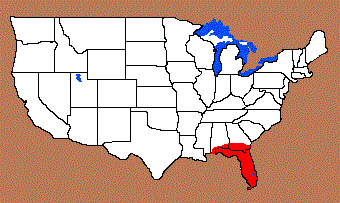
Distribution Comments:
This point is primarily found in Florida and into southern Georgia and southern Alabama.
This point is primarily found in Florida and into southern Georgia and southern Alabama.
Age / Periods:
Date: 3,500 - 2,500 B.P.
Cultural Period: Late Archaic to Early Woodland
Glacial Period: Neoglacial
Culture:
Date: 3,500 - 2,500 B.P.
Cultural Period: Late Archaic to Early Woodland
Glacial Period: Neoglacial
Culture:
Age Details:
Other points in this cluster / Related / Associated Points:


